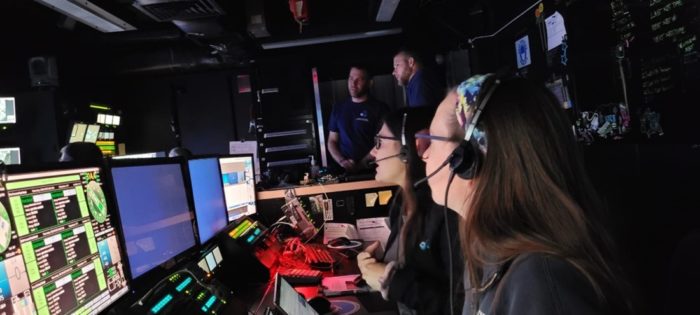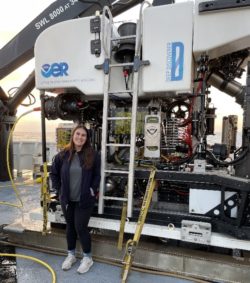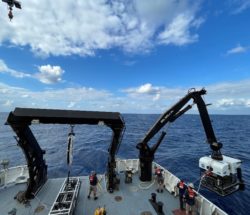
Diving Deep: Exploring the Ocean on NOAA Ship Okeanos Explorer

Live from the control room! Here you can see me (middle) and Sample Data Manager Anna Lienesch (foreground) sharing information via telepresence as the dive was livestreamed to shore.
By Patricia Albano, National Marine Sanctuary Foundation Internship Program Coordinator in support of NOAA Ocean Exploration

Standing next to 8-foot tall ROV Deep Discoverer is a great way to be reminded of just how vast the deep sea is and how robust our tools must be to explore the unknown!
The thick fog cleared with the rising sun and the air buzzed with anticipation and curiosity for the field season of deep-sea exploration that lay ahead. As a newbie to NOAA Ship Okeanos Explorer, I was particularly excited for the adventure, though even seasoned sailors joined us first-timers to watch the last views of land fade into the distance. With one last wave to our departure port of Pascagoula, Mississippi, the Okeanos Explorer set off on its first expedition of the year, dubbed the 2022 Remotely Operated Vehicle (ROV) and Mapping Shakedown. As its name implies, the aim of a shakedown expedition is to “shake down” any potential kinks before a full field season of seafloor mapping, ROV operations, and telepresence. New protocols are tested, novel technologies are integrated, systems are calibrated, and team members are trained to ensure that each subsequent expedition meets its mission goals. On this expedition led by NOAA Ocean Exploration, some of the main objectives were testing the sonar systems used for seafloor mapping, getting ROVs Deep Discoverer and Seirios into the water after their long off-season in the workshop, and integrating a new low-light camera system to capture bioluminescent organisms on high-definition video.
While walking along the ship’s decks, the ROVs (which are much bigger in person than you’d think!) command attention with their manipulator arms, cameras, and light systems. Potentially even more impressive are the onboard crane systems that lift the 9,150-lb ROV Deep Discoverer and 3,500-lb ROV Seirios into and out of the water each day after soaring through the abyss. While it is easy to find yourself enamored by the cutting-edge technologies that make ocean exploration possible, perhaps the most impressive part of NOAA Ship Okeanos Explorer is the team of people that make things really come to life. The passageways of the ship are busy, just like hallways in an office, with team members hurrying to stand their watch on the bridge or headed to the control room to pilot an ROV. Over meals in the ship’s galley, we discuss the incredible coral garden that was discovered, what needs to be fixed on the ROVs that evening, the plan for overnight seafloor mapping operations, and where we are going tomorrow. Just like the Big Apple, the ship is like a city that never sleeps – once the ROVs are tucked away for the night, the sonar systems are fired up and the mapping team burns the midnight oil while collecting data on the seafloor below us. Each day brings new opportunity for innovation and discovery.

Each morning, the mission team donned hard hats and excitedly watched the ROVs get deployed for the day.
The 2022 ROV and Mapping Shakedown completed each of its 7 planned ROV dives and carried out all its seafloor mapping operation goals. The team identified an underwater cultural heritage site as the target of our second dive of the expedition. As Deep Discoverer and Seirios descended into the deep, we (along with excited scientists and marine archeologists on shore) watched in anticipation from the ship’s control room, hoping to find the remains of the shipwreck (likely a 19th century whaler) that was thought to be in this location. Everyone was thrilled to see imagery of an anchor and tryworks (a furnace that was used to turn whale blubber into oil) come into view. On the last dive of the expedition, we targeted the rise of an undersea canyon in the Straits of Florida. Almost like a reward for a week’s worth of arduous work, the ROVs were greeted with a highly biodiverse coral garden. Sharing this discovery with folks back on shore via telepresence video, the science team explained the different coral species present and the organisms (like squat lobsters and sea stars) that called this environment home.
As Internship Program Coordinator, my role is to ensure we are providing opportunities to train the next generation of ocean explorers. Through programs like NOAA Ocean Exploration’s Explorer-in-Training, students and early career professionals can join the Okeanos Explorer at-sea for hands-on skill building opportunities. After sailing on the 2022 ROV and Mapping Shakedown expedition, I can attest to the perspective-changing takeaways that come from this immersive experience. More information about NOAA Ocean Exploration’s student opportunities can be found on the office’s website. Moving forward, I am excited to share my experience with prospective students who are interested in ocean exploration themselves as we continue to unearth the mysteries of Earth’s final frontier.

Tryworks and anchor — the only remains of the shipwreck found on Dive 2 of the 2022 ROV and Mapping Shakedown. The two fish here, likely cusk eels, are commonly found on shipwreck sites. Image courtesy of NOAA Ocean Exploration, 2022 ROV and Mapping Shakedown.
